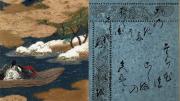One need not know how to read Japanese calligraphy, nor even have taken in the thousand-year-old Tale of Genji in translation, to savor The Tale of Genji: A Visual Companion, by Melissa McCormick, professor of Japanese art and culture (Princeton, $45). The story she tells, drawing on the justly famous underlying work (see “Vita: Murasaki Shikibu,” May-June 2002, page 32, illustrated by some of the art discussed below), is simplicity itself—so long as one can overlook the remarkable survival of a fragile masterpiece for more than five centuries. An associated exhibition—on the artistic tradition inspired by the novel, curated by McCormick—opens at the Metropolitan Museum of Art on March 5. From the introduction:
In the year 1510, at a private residence in the capital city of Kyoto, two men raised their wine cups to celebrate the completion of an extraordinary project, an album of 54 pairs of calligraphy and painting leaves representing each chapter of Japan’s most celebrated work of fiction, The Tale of Genji. One of the men, the patron of the album Sue Saburo, would take it back with him to his home province of Suo (present-day Yamaguchi Prefecture), on the western end of Japan’s main island. Six years later, in 1516, the album leaves would be donated to a local temple named Myoeiji, where the work’s traceable premodern history currently ends. In 1957 it came into the possession of Philip Hofer (1898-1984), founder of the Department of Prints and Graphic Arts at the Houghton Rare Book Library of Harvard University. A prolific collector of illustrated manuscripts, Hofer purchased the album along with numerous other Japanese books and scrolls, which were subsequently bequeathed to the Harvard Art Museums in 1985. This remarkable compendium has survived intact for over 500 years, making it the oldest complete album of Genji painting and calligraphy in the world.…
Although steeped in the complex belief systems and moral codes of its own era…the tale can be read as a monumental exploration of human nature. No matter how characters may triumph or what virtues they may exhibit, all ultimately confront hardships and grapple with their own fallibility, none more so than the eponymous protagonist Genji. To give voice to her characters’ internal conflicts and thought processes, Murasaki Shikibu took unprecedented advantage of…the affective power and ironic distance effect of waka poetry, and a mode of prose narration similar to stream of consciousness and free indirect discourse in Western literature. The shifting perspective of the narrator throughout the work also makes for a reading experience surprisingly akin to that of the modern novel.









